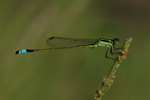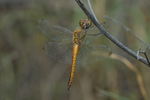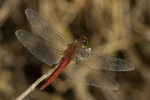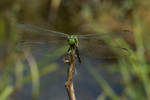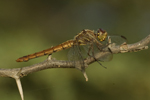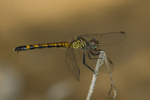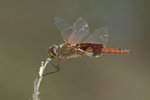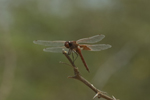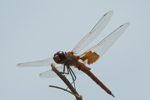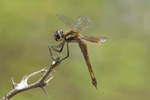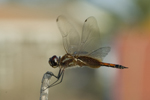
 Dragonflies & Damselflies of Aruba & Curacao Theo & Mars Muusse - the Netherlands
Dragonflies & Damselflies of Aruba & Curacao Theo & Mars Muusse - the NetherlandsPhoto Index on Curacao dragonflies (March 2009).
List of locations and observations on Aruba. Places on Aruba and list of dragonflies (July - August 2007).

Rambur's Forktail (Ischnura ramburii). A common damselfly around the Caribbean.
On Aruba it is found whenever there is water. It also visits semi-salty waters like the ponds on Noord-Aruba and near the Natural Bridge.
Ovipositing females have been found too, also on most waters and for example many at Bubali and at the sewage pool in Noord-Aruba where no less than 16 copula were counted during one visit. The species needs floating vegetation to lay her eggs in.
The fresh male found at Pirikichi was brilliantly apple-green in coloration and transparant, suggesting it was 'born' that day.
Note the blue, andromorphic female.
.
.
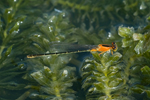

.
Wandering Glider (Pantala flavescens). Not yet recorded before on Aruba as far as I know. It's a long distant migrant from the Tropics.
Seen on various spots after July 27 2007, where it was not seen before that date. Small groups have been recorded too, with no less than 4 individuals at Bubali, 5 at St Ana Church and 4 at Ceroe Cadushi. This may indicate new arriving groups. At the end of my stay, from 9 – 12 th August 2007, larger groups were found with numbers reaching 20+ imago’s a spot. At Bubali, for instance, this species (40 imago’s) was seen together with P. Hymenaea (1) and Tramea calverti (70 imago’s), flying around the treetops at 2 pm.
At St Ana Church, the species was seen together with the other Pantala, the Spot-winged Glider (and Orthemis and Tramea). In direct comparison, Wandering Glider is slightly thinner, paler and came really close to the observer.
It could be found hanging in the late afternoon, in long grass or low in bushes, while the Spot-winged Gliders have not been seen on the ground. They tend to fly somewhat higher around the bushes (in the late afternoon) and stayed in the air while the Wandering Gliders came down to rest.
Note the difference in markings between males and females on the abdomen, varying in darkness and amount. Only a few real orange-tinged males were seen. Note the yellow in the wing and the long appendages for a female. The species has not been seen ovipositing yet but looking at the ponds it is flying close too, this may easily be happening. Males tend to outnumber the females or females are more difficult to see.

.
Tawny Pennant (Brachymesia herbida). A common dragonfly on Aruba.
Its favourite habit is to sit high in Acacia trees while looking for small butterflies and other insects.
It can be seen in good numbers around sewage ponds and of course Bubali.
It is a much longer and more slender species than its relative Brachymesia Furcata, also seen here daily.
.
Red-tailed Pennant (Brachymesia furcata). Common all around Aruba.
It is seen nearly everywhere, also at the salty Frenchmen’s Pass. At small ponds in drier parts of the Island, it can be abundant. Wandering non-adult males and emales have been seen far away from water suitable for ovipositing. For example, Red-tailed Pennant has been recorded along the beach at Arashi, in the drier areas of Arikok and on Mount Savaneta.
Near its breeding ponds, it is always flying around with great speed, chasing other dragonflies away, no matter how big.
The ovipositing of the also reddish female (in floating vegetation) is guarded by the male. It then flies fast around the female in small circles making it hard to follow with the naked eye.
Note how the perching male (picture 4) gets rid of a Skimmer.
Great Pondhawk (Erythemis vesiculosa) is one of the most splendid species you can encounter on Aruba.
It is rare on Aruba but seen on 4 spots so far. Most were seen in a private garden near Fontein, in the Arikok NP (4 males on July 28 2007). This garden is fed by a stream made by a well. It creates standing and small flowing pools with a lot of grassy vegetation around it. Other places are Bubali (1 female, July 18 2007) where the species was seen before by Roselenn Croes, the Hospital, and at the South-Eastern Gate of the Arikok NP (1 male on both visits).
It it a large species which tends to sit more frequently than others, favourably above the water, on a branch.
.
Aruban Skimmer (Orthemis arubensis).
The Orthemis family is very difficult to identify since there is no consensus about its status.
There are a few readily discernable species but the violet/ purple/ dark red species are not yet fully understood.
On Aruba there may be more than just one species involved although the coloring of eyes, nose, underside of the thorax, abdomen and ptreostigma look homologous on all animals seen here. There is also no visible difference in its hamulus, and in the female, the shape and colour of its valves on S9 does not seem to vary. Also, note the markings on the thorax on female and immature male, looking alike in the pictures.
So far, I will call it Orthemis arubensis on this website, until there is more transparancy.
Roughly it looks like a cross between O. discolor and O. ferruginae, with characters of both.
Its commonly seen here, whenever there is water.
It also appeared at the very salty Frenchmen’s Pass and at dry places as well as near the coast.
It is never seen in large concentrations, although at the Fontein, the males territories were smaller, sitting only a 7-8 metres from each other.
The Skimmers tend to be less territory in relation with the Red-tailed Pennant. Quite a few times the Skimmer male was seen being pushed off a good spot above the water by the smaller Pennant. The Pennant could succesfully keep the Skimmer from the branch.
.
Seaside Dragonlet (Erythrodiplax berenice) is unique in its behaviour.
The eggs and larvae are capable to survive in salt water, so it can fill a niche not many other insects can.
At Frenchmen's Pass it is abundant along and in between the mangroves.
The colour of the dragonlet changes from yellow to black and yellow in females and the males become all blue-gray prunosed when maturing. Probably present at other mangrove sites, but not searched for yet.
.
Seaside Dragonlet (Erythrodiplax berenice), female, Spanish Lagoon, Aruba.
This dragonfly has a diagnostic habit in flying with its abdomen held downwards, hanging. The obvious dark patches in the wing are accentuated when doing so.
There are a few red species known to occur around the Caribbean. Probably, more than one species are involved since 2 of the red males seen on Aruba (1 location) did not show the black spots on S8 and S9, seen on the others observed.
Red Saddlebag is another red species that is widely distributed across the region. Its face is pale brown initially but turns red in mature males. The thorax is brown and unmarked. The wings have reddish-brown veins anteriorly and the hindwing have a large basal brown crossband that doesn't generally extend beyond the midrib of the anal loop. Generally there is a large central clear spot in this crossband. The legs are pale turning black more distally. The abdomen is yellowish-brown in females, but turns red in mature males. Segments 8-10 are black dorsally and pale laterally.
They are difficult to photograph since they are the last ones still flying around in the late afternoon when other species perch and can be approached. This species is seen at temporary or permanent ponds.
.
This species is recognized by its striped thorax, both in males and females. In males, the underside of the abdomen is black as are S8 – S10, with small pale lines at the base of these segments.
The dark spot in the hindwing is not as broad as in onusta, it looks more circular and more restricted. In females, the spots are smaller, restricted to the basal part of the hindwing.
Note the shorter and rounder hamulus when compared to onusta. In females, the thorax is striped too, the abdomen is warm yellow-orange with the same distinctive black S8 - S10 as in males. Note the extending ovipositor.
The nose is pale to red, the mandibles are pale and there is a black line over the frons.
August 8th to August 12th 2007, numbers rose quickly with large groups seen at various spots. During those days it was observed at many locations, migrating/ wandering males and females seen easily. In July and at the start of August, this species was absent.
.
Description: size of P. flavescens, although in direct comparison it looks more robust, slighty bigger and darker. Obviously larger than surrounding Brachymesia. The dark colour of the abdomen is caused by dark spots/ markings on the central upperside, the ground-clour of the abdomen being dark yellow-brown. The dark eyes and the absence of a pale grey thorax give them a totally different colour in direct comparison with the Wanderings around.
Hind-wings very broad with a very dark, small spot at the lower base of the hindwing.
This spot is visible when it is seen flying slower and coming real close. The pterostigma is dark and small.
Abdomen orangy brown-yellow with obvious black markings at the upperside. Lower side of abdomen grayish. S1 and S2 broader than S3 and S4, abdomen broader around S8. No very long appendages visible. Thorax grayish brown with a dark band and the sides.
Eyes red-brown above, grayer below. Nose orange/ reddish.
Behaviour: only seen flying, erratic with unpredictable moves. Hunting in a small area next to a tree but now and then not avoiding the strong wind. The two Gliders at St Ana Church, where seen together with P flavescens, posessed larger territoria, but these were both males.
Difficult to follow through binoculars; making pictures is almost impossible.
After one hour the Soledad female flew off. Seen between 5 and 6 pm. The two males at St Ana Church remained in the air between 4 pm and 6.30 pm, not coming to rest once.
The three individuals showed the same characters, being the same species. All show the semi-circular dark spot at the base of the hindwing, close to the edge.
The fourth and fifth Spot-winged Gliders appeared at the Hospital (1) and at Bubali (1) both found in large swarming groups of P flavescens and T calverti suggesting they had just arrived with them. The male at the Hospital appeared paler with less markings on the upperside of the abdomen and the ground-colour of the abdomen is paler orange-yellow.
A single observation of an orange-red sympetrum may well have been this species.
Description; a small dragonfly with obvious orange-red abdomen and an obvious yellow spot at the base of the wing was seen during a short 2 minutes. It was sitting on a branch at 30 cm above the ground and could be observed from 3 metres with binoculars.
It immediately reminded me of a Sympetrum of the old world, with all red/ orange-red abdomen with small dark markings on S8 and S9, obvious yellow at both bases of the wing, orangy/ yellowish veins at the first half of the wing and pale whitish rectangular spots at the lower sides of the brown thorax. The ptreostigma’s were reddish, the eyes red on top and browner below. The legs were pale.
This however leads to the unlikely identification of Sympetrum illotum, a new species to this area…
Description; a medium-sized dark dragonfly seen for 1 minute.
It was disturbed from a grassy terrain in a dried out pond at Noord. It flew into a bushy complex. It looked all dark. Obvious were the large white spots on S7 and the green eyes.
Not many details seen but the sides of the thorax looked paler and striped, suggesting didyma. May have been a male ocellata though but obvious blue-gray prunose on upperside of thorax not confidently seen.


